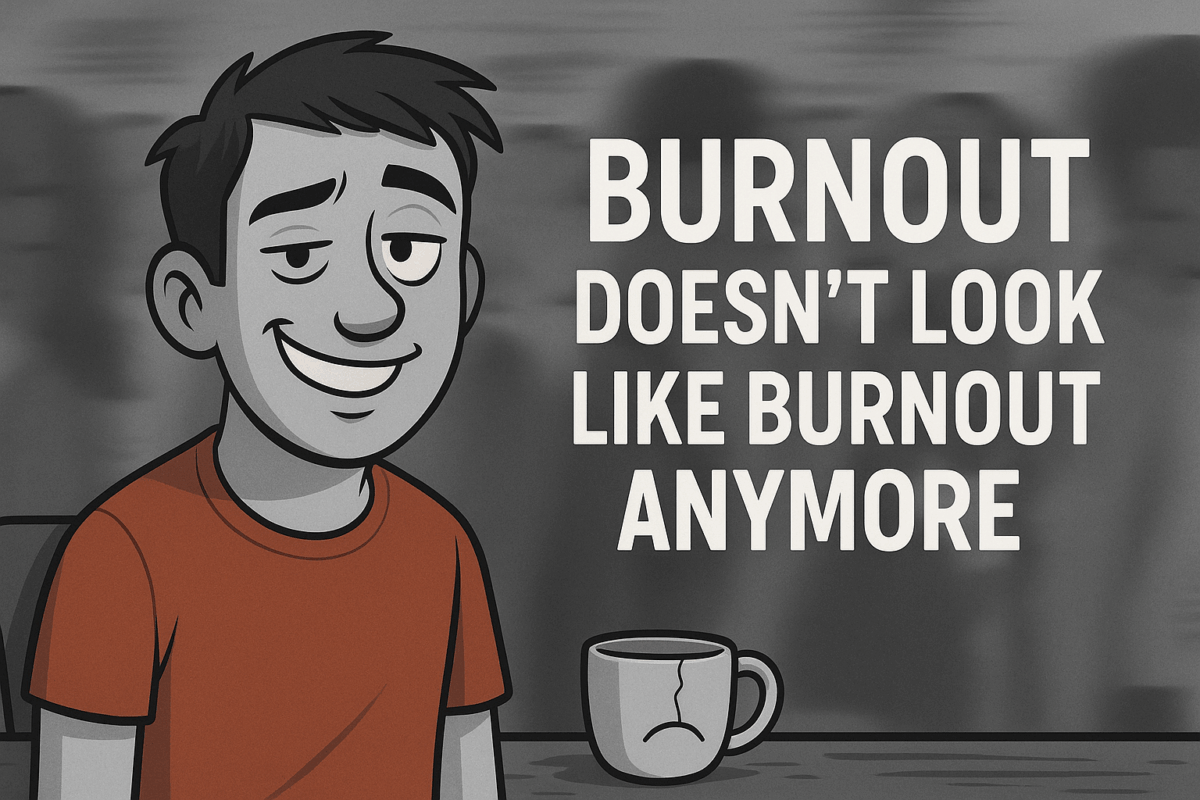
Why Burnout Doesn’t Look Like Burnout Anymore
You’re replying to texts. You’re keeping up with work. You’re not crying in bed or falling behind. You’re functioning.
And you’re absolutely cooked.
This is what high-functioning burnout looks like now. It’s not collapse. It’s compression. It doesn’t show up in dramatic breakdowns, it shows up in “I’m fine.”
TL;DR: Quick Signs of High-Functioning Burnout
- You’re tired but still productive
- You feel emotionally flat
- You wake up already exhausted
- You stop feeling like yourself
- You’re always holding it together, but barely
Burnout Isn’t Always Loud
Classic burnout looks like breakdowns. But the modern version? It’s quieter. Sneakier. And it thrives in people who seem like they’ve got it together.
Modern burnout symptoms include:
- Going through the motions on autopilot
- Being “productive” but feeling emotionally detached
- Nodding through conversations you don’t absorb
- Sleeping 8 hours and waking up wrecked
These are emotional exhaustion symptoms hiding behind high-functioning habits. Burnout doesn’t scream anymore. It shrinks.
The Pressure to Perform Through Burnout
You’re the strong one. The one who keeps the house running, checks in on friends, hits deadlines. But that strength? It’s become performance art.
You’re not okay, but you keep showing up. Because we’re told that falling apart is failure. So instead, we smile. We reply to emails. We keep folding laundry while quietly falling apart.
Until something tiny, a wrong text, a burnt piece of toast, tips you over. That’s a mental fatigue warning sign. And it’s more common than we think.
Burnout in the Era of Constant Input
You’re not tired just because you’re busy. You’re tired because your brain never shuts off. The tabs never close.
Between newsfeeds, notifications, work chats, emotional labor, and every “can I just pick your brain?” text, you’ve got invisible labor exhaustion.
There’s no space to think. No silence. No decompression.
Burnout today comes from too much everything. And if you’re a caregiver, parent, or the go-to friend, your exhaustion’s running on expert mode.
The Rise of High-Functioning Burnout
You’re doing “all the right things.” You’re productive. Reliable. Present.
But behind the scenes:
- Nothing feels fulfilling
- You forget what you were saying mid-sentence
- You feel like a ghost inside your own life
This is what burnout feels like now. Not loud, but low-level suffocating. You stop feeling like yourself, and you’re not sure when the shift even started.
Why It Hits “Strong” People Hardest
If you’re the helper, the emotional support human, the one who’s always “okay”, you’re most at risk.
Because your identity’s wrapped up in showing up. And when that identity starts to erode, it’s terrifying to admit.
So you keep going. Keep smiling. Keep helping. Until one day you can’t.
This is burnout in caregivers and over-functioners. It’s not obvious. It’s slow erosion. And people don’t notice, because you’re still doing everything. Just with no fuel left.
Burnout Recovery Doesn’t Look Like “Just Take a Break”
Telling someone deep in burnout to “just take a break” is like tossing a Post-it note at a bushfire.
You don’t need a day off. You need:
- Space where you’re not useful to anyone else
- Room to unravel without guilt
- Boundaries that hold even when you’re tired
- Rest that feels like relief, not shutdown
- People who don’t expect you to perform
Burnout recovery help starts with permission. To stop. To be soft. To be human again.
FAQ
Emotional numbness, exhaustion even after rest, short temper, detachment, and constantly overfunctioning while feeling hollow.
It’s a flatness. You’re not sad, just numb. Like you’re running on fumes but still going because stopping feels unsafe.
Start with boundaries. Reduce emotional labor. Let go of non-urgent obligations. Seek support that doesn’t require performance. You don’t need to quit life, but you do need to quit carrying it all alone.
Still Not Sure? Start Here.
If you’re reading this with a knot in your stomach or thinking, “How do they know?”, it’s probably you.
Start with The Strong One Is Tired. It’s not a workbook. It’s not a fluffy guide. It’s a brutally honest permission slip.
A burnout recovery book for the emotionally fried. The quietly unraveling. The people who can’t even figure out where the overwhelm ends and they begin.
Grab your copy of The Strong One Is Tired, a no-fluff burnout survival guide for high-functioning humans with nothing left in the tank.
Read the BookYou’re Not Lazy, You’re Burnt Out (Here’s How to Tell the Difference)
Can’t function, but feel guilty for resting? This isn’t laziness. This is burnout. Learn how to tell the difference, and start recovering.
How to Rest Without Feeling Guilty (Even If You’re Cooked)
Tired but can’t switch off? This guide shows you how to rest without guilt, even if your brain insists you should be doing more.
Why Being the Helper Is Quietly Destroying You
Being the helper feels noble, until it leaves you emotionally empty. Here’s why being the strong one is exhausting you and how to take your energy back.
How to Set Emotional Boundaries Without Explaining Yourself
You don’t need to host a TED Talk every time you protect your peace. This guide teaches you how to say no without guilt, drop the over-explaining, and reclaim your damn energy. Because your nervous system deserves better.
Why Burnout Doesn’t Look Like Burnout Anymore
You’re still functioning, but you’re also fading. This article exposes the quiet truth about emotional burnout, how it’s changed, and what modern burnout really feels like.
10 Signs You’re the Strong One in Every Room (and It’s Wrecking You)
You’re the reliable one. The rock. The unpaid therapist. But constantly carrying everyone else’s chaos comes at a cost, and it’s probably already showing up in ways you’ve been taught to ignore. This one’s for the strong-but-cooked.







